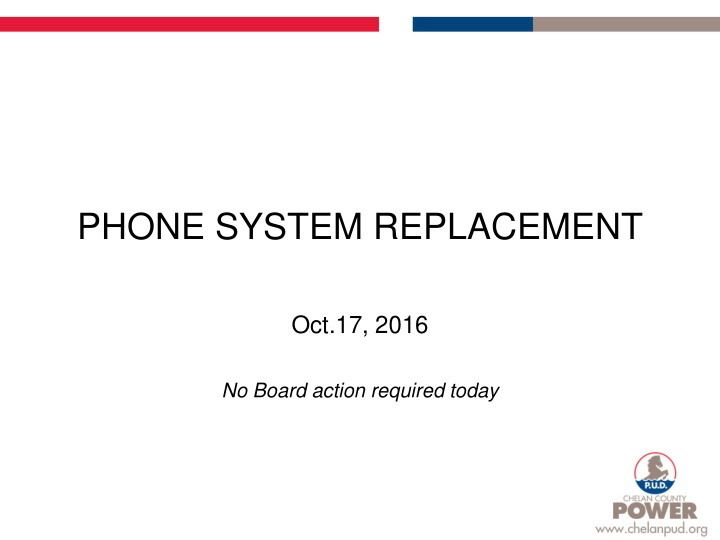



PHONE SYSTEM REPLACEMENT Oct.17, 2016 No Board action required today
WHY REPLACE? • Current phone system is obsolete – 13-year-old equipment – No longer supported by manufacturer – Difficult to buy replacement parts – Increasing risk of failure – Legacy technology
PROJECT HISTORY (alternatives evaluated) • Original PBX Scope (circa 2012): Upgrade – Value and benefits • Gained manufacturer support (software and processor upgrade) • Lower initial cost • Minimal plant/infrastructure changes • Quick deployment – Considerations • Transition solution (limited period of support) • Reuse of hardware, devices, equipment • Higher overall replacement cost Project budgeted $720K • • Determined the solution did not provide best value for our customer-owners – Short lived solution – Did not provided long-term reliability – Limited manufacturer support • Project suspended: No capital spend – Continued maintenance of existing system – Budgeted $100K for feasibility study • Additional exploration needed to refine budget – Revised capital budget to $600K for future improvement
PROJECT HISTORY (alternatives evaluated) PBX scope (circa 2015): hybrid solution • – Phased implementation to Internet Protocol (IP) platform – Cost and technical incentive to remain with current manufacturer – Procured consultant support – Issued RFP 15-36 • Board Presentation on Jan. 18, 2016 – Update on telephone project – Planned return on Feb. 1, 2016 • Project budget revision ($1,471,824 forecasted) • Award of RFP 15-36 • Final assessment did not support a hybrid solution – Migration solution did not meet technical and financial requirements – Required intricate “work-arounds” to provide necessary functionality – Required stronger integration efforts between IT and Telecom – Long deployment schedule and higher overall implementation cost • RFP 15-36 canceled in April 2016
LESSONS LEARNED • Going Forward: – Follow the District-developed Engineering & Project Management program – Apply the District’s standards and best practices – Effective collaboration – Embrace Cycle of Personal Ownership (CPO) • Fully embrace and execute on the key concepts identified within the Cycle of Personal Ownership. – Establish clear expectations – Have complete agreement/understanding on the project scope – Obtain commitment from team members to fully execute within their defined respective roles and responsibilities – Use project management process to aid in the early detection of these issues.
ACTIONS TAKEN • Re-engaged stakeholders to define current and future needs • Joint IT/Tech Shop effort to develop integrated solution – Captured all related projects under one • Evaluated four leading telephony vendors available on State contracts – Access competitive pricing with much shorter procurement schedule • Compared detailed scope and pricing between top two vendors • Selected Cisco/CompuNet based on best value
NEW PROJECT SCOPE • Complete Replacement - full IP platform • Immediate paradigm shift in technology – Value and benefits • Achieves full manufacturer support • Lower overall implementation cost than hybrid solution • Maximizes the value and benefits of our IT network • Portability of the system (gained operational efficiencies) • Recovery of telecom space • Industry standard platform – Notable requirements • Dependency on the IT network • Make ready work required (added cost) • Need to move to a distributed platform
SYSTEM FEATURES • Voice over Internet Protocol (VoIP) – Software-based distributed design – Uses highly reliably business network for call routing – Enhances business continuity communications model • Call Center capabilities – expandable and adaptable to allow for multiple means of communications • Supports Unified Communications
CUSTOMER EXPERIENCE • Advanced Call Center Capabilities – Intelligent routing to the most appropriate resource: Skills based – Enable Email and Chat interactions – Web-based desktop agent: Best positioning for future CIS integration – Advanced reporting tools – Maintains high level of customer service
UNIFIED COMMUNICATIONS • Presence • Instant Messaging • Click-to-call • Web conferencing • Desktop/File sharing • Video integration ready • Mobility Integration • Unified Messaging
ADDITIONAL ENHANCED FEATURES • Voicemail • Conference bridge • Call recording • Switchboard Attendant Consoles • Emergency Responder - provides security and first responders with granular location information • Allows for future automated emergency notification, radio integration
SCHEDULE • 2016 – Detailed design and implementation process with CompuNet/Cisco – Wiring upgrade effort – Continued stakeholder engagement • 2017 – Purchase new Cisco system using State contract – Deploy and test new system – User training – Flash cutover to new system – Remove old equipment
COST ESTIMATE • System Replacement $1,821,000 – Phone System and Labor – Network Wiring – Backup Power – Unified Communications – Eng, Proj. Mgmt, IT support, Planning – 15% Contingency
NEXT STEPS • Seek approval of budget revision resolution – Nov. 7 • Budget revision requested: $1,221,000 – Current approved budget: $600,000 – Revised project cost: $1,821,000 • Equipment purchase to be made under Delegated Authority
QUESTIONS
Recommend
More recommend